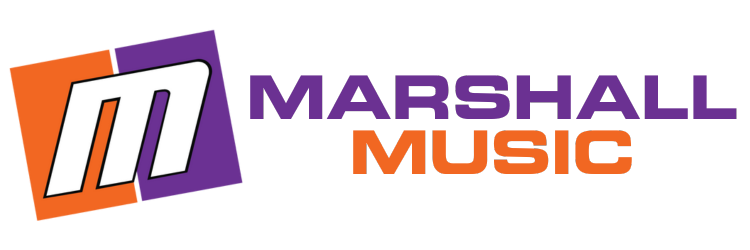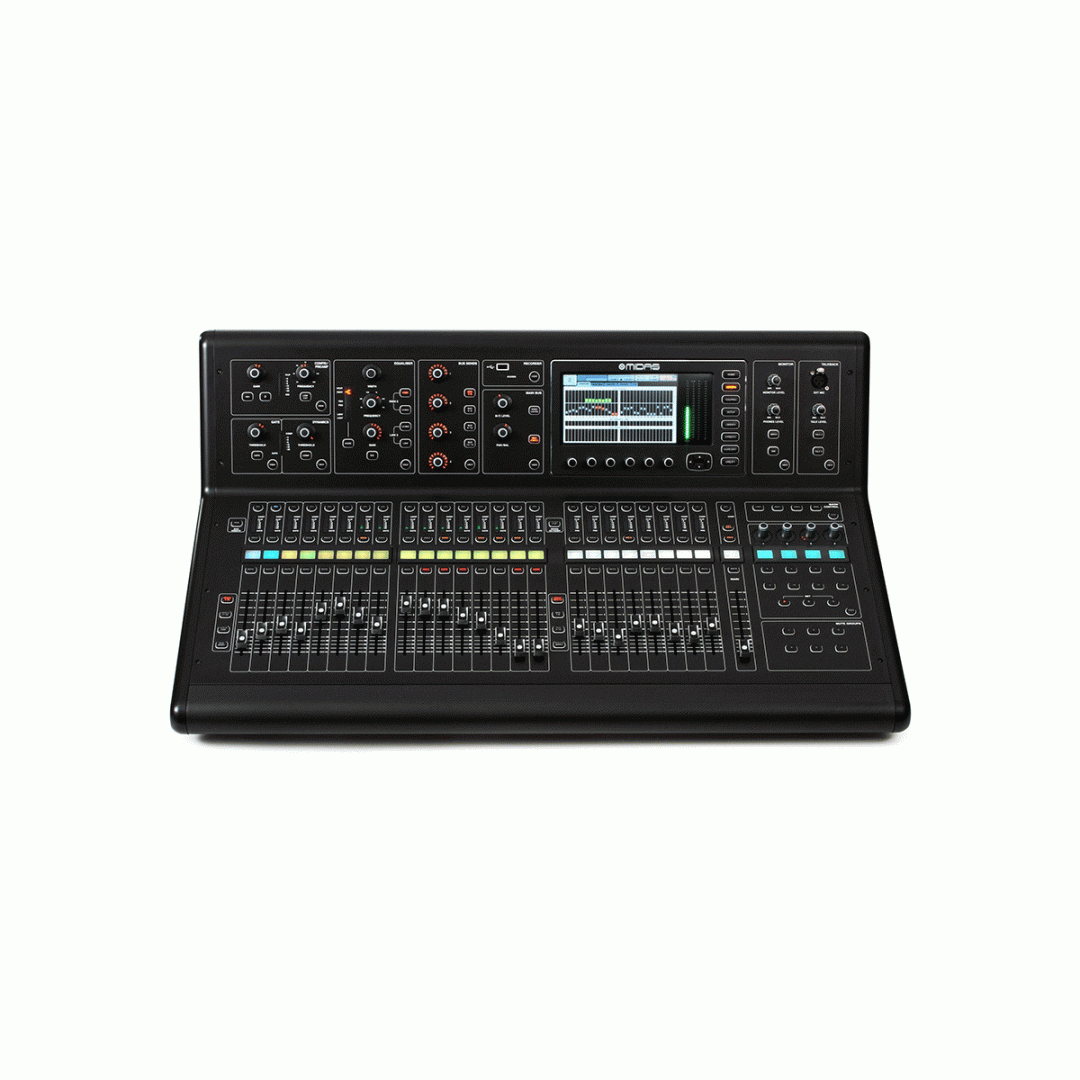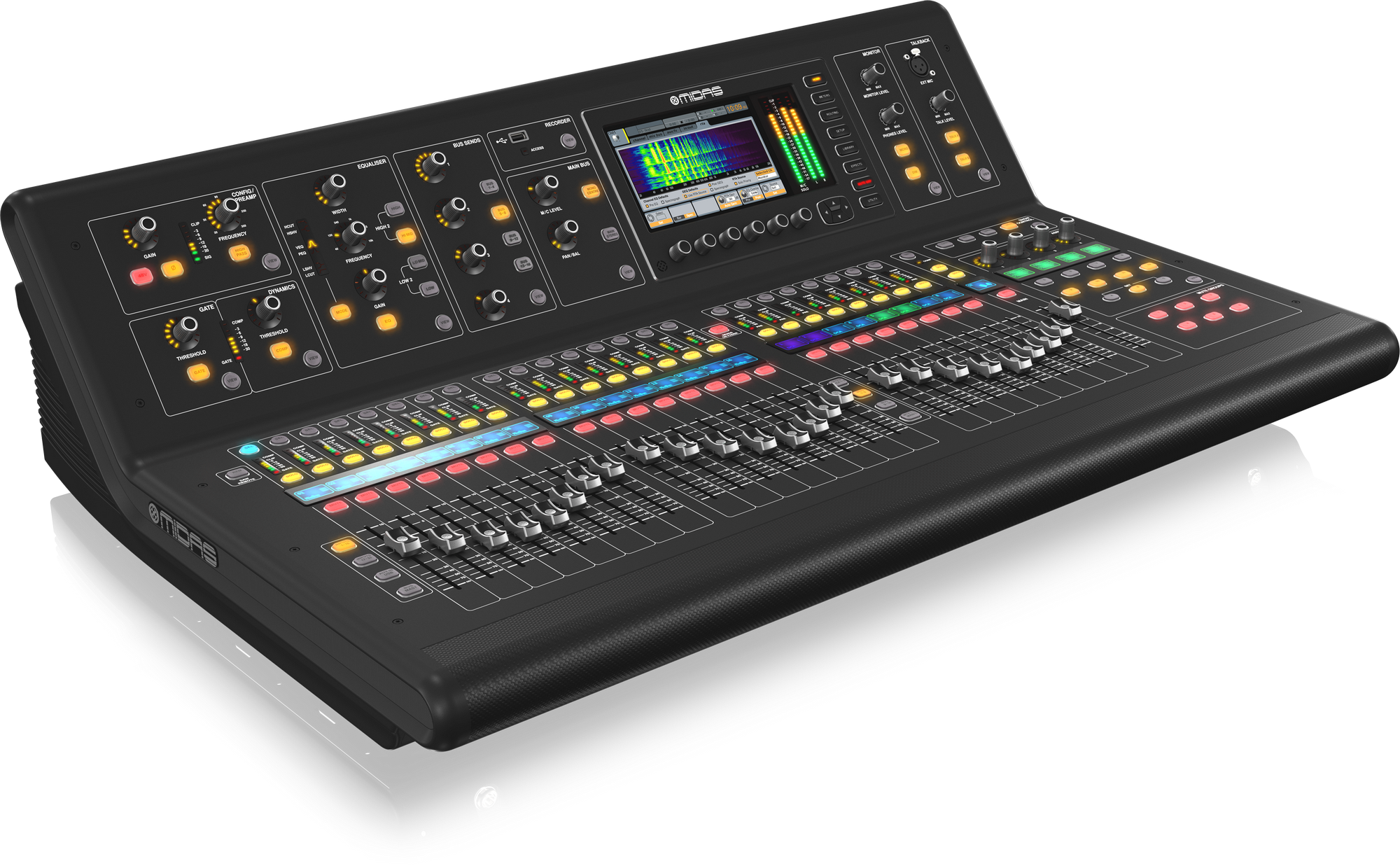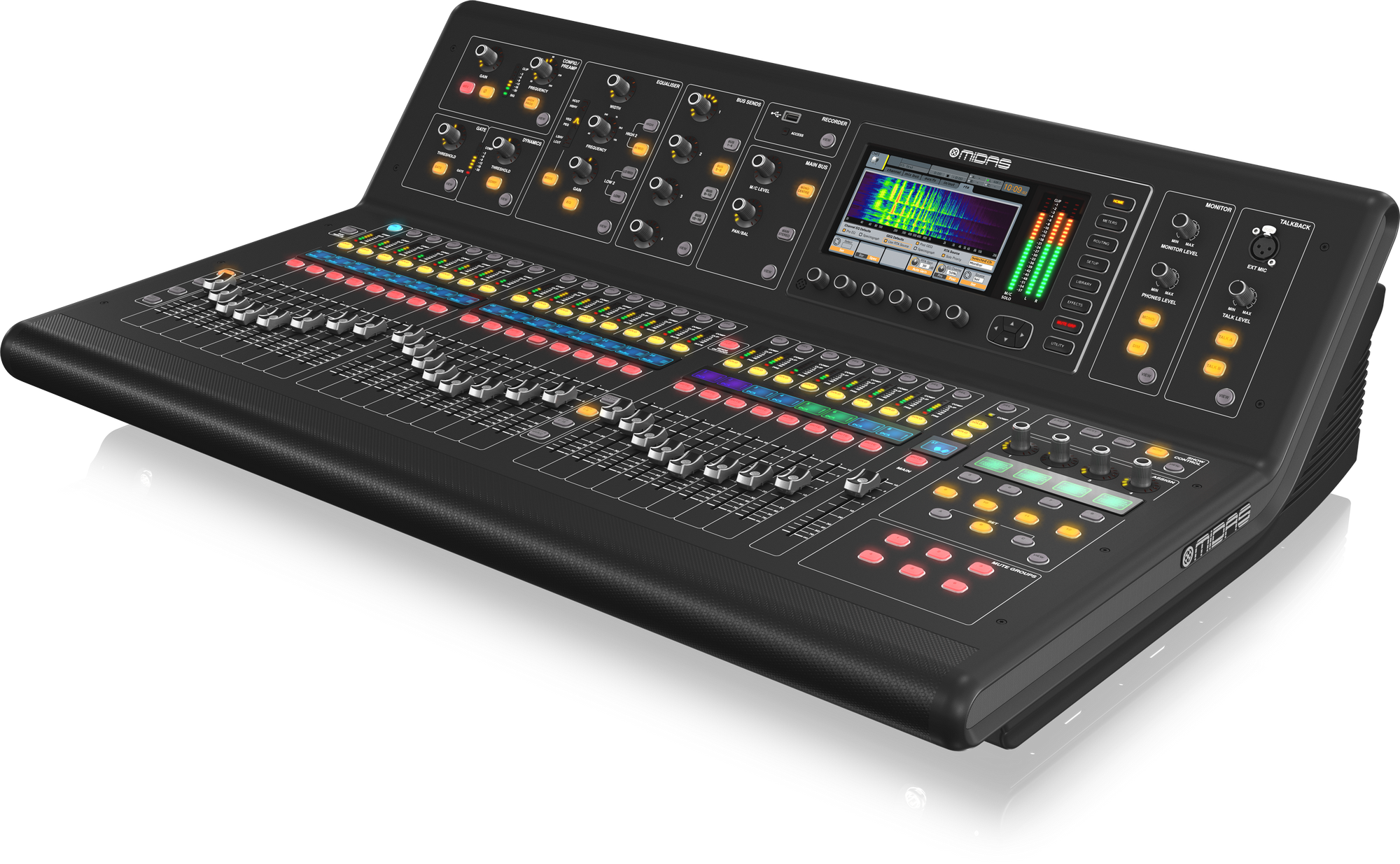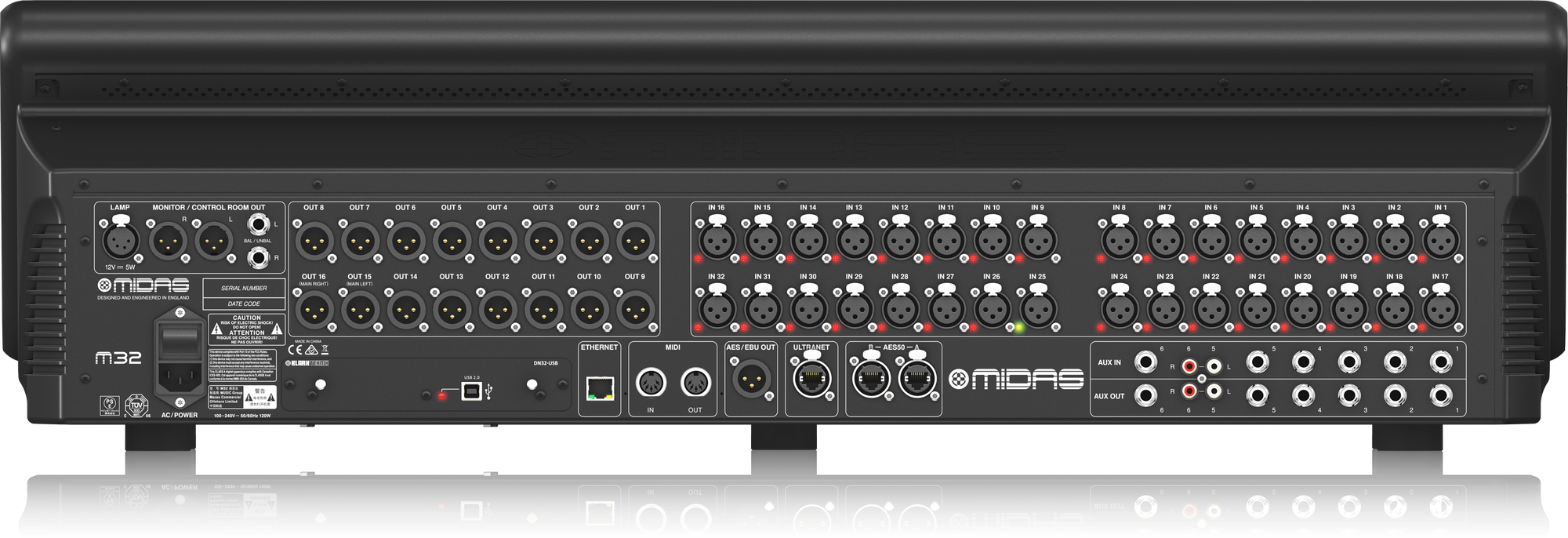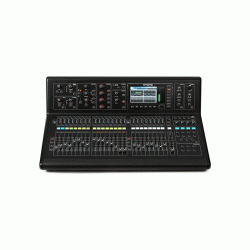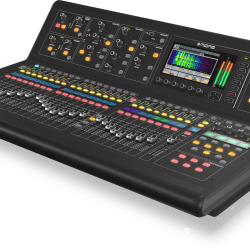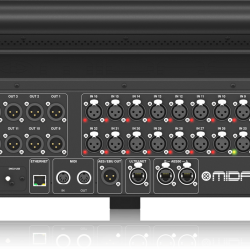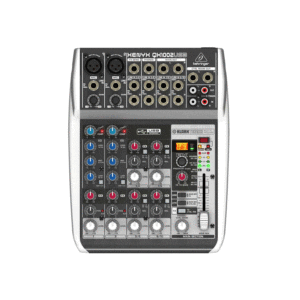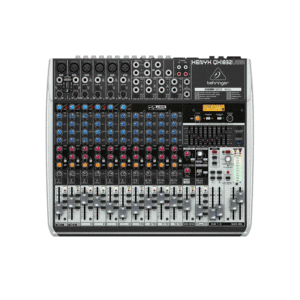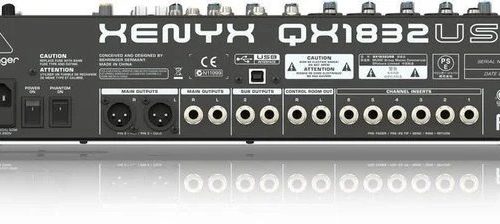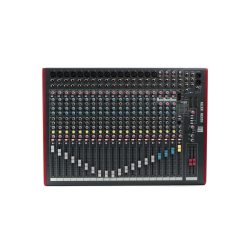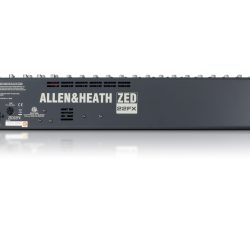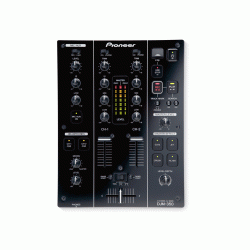Designing A Future Classic
Our goal for M32 was to combine the best of classic British console designs with advanced modern technology to completely redefine what a medium-format live console can offer.
We began the industrial design process by drawing inspiration from a somewhat unexpected source – the luxury and high-performance car industry.
Why High-Performance Cars?
Simply because the design teams at Aston Martin *, Bentley *, Rolls Royce *, and other leading manufacturers are skilled at introducing innovative technological advancements while simultaneously maintaining the feel, essence, and intangible qualities of their cherished brands. And in essence, that’s the challenge we too faced when creating the M32 console.
So in order to create a future-forward design that took the MIDAS legacy even further, we enlisted the help of Rajesh Kutty, a leading industrial designer known for his work with celebrated luxury auto manufacturers such as Bentley, etc.
Kutty started by examining the design elements that have made MIDAS consoles so highly sought after – from the straightforward, logical layout to the unparalleled usability and ergonomics. These are characteristics that live sound engineers around the world have come to rely on, and are key aspects of the MIDAS legacy.
With these design elements in mind, Kutty set forth to create a styling that would be modern, innovative, futuristic, and stunningly elegant.
Many different construction materials were tested. Countless design variations were explored. And in the end, a styling was chosen that represented the perfect marriage between aerodynamic artistry and uncompromising performance. The design is both ultramodern and distinctly classic at the same time.
The Landmark in Console History
A close look at M32 reveals that the styling is completely new in every sense of the word. Rajesh Kutty’s automotive-inspired design elements mesh perfectly with a recognisable MIDAS signature, setting the M32 apart from any other console. Its beautifully streamlined and elegant form factor completely revolutionises the experience of live mixing.
The MIDAS M32 construction is equally impressive, and is designed to offer you years of reliable performance while withstanding the demanding environment of live performance venues. M32 employs a predominantly space-frame construction, with parts of the sub-frame consisting of durable and lightweight carbon fibre and aluminium. Multiple alloys have been employed throughout to guarantee maximum component efficiency and an improved performance-to-weight ratio.
The M32 is an innovative, evolved design that brings together modern construction principles and high-tech materials into a styling destined to go down as a landmark in console history.
MIDAS is the Epitome of Excellence
In 2013, MIDAS approached me to create a new design language for MIDAS and with it a new mixing console. Having designed for Bentley, I am intimately familiar with the challenge of transforming a brand while retaining the precious heritage – in this case the 40 year old iconic British mixing console brand MIDAS.
Representing the pinnacle of its industry, MIDAS is the Epitome of Excellence. When it comes to ergonomics, performance and style, the aspects of a high-performance luxury carequally apply to a high-end mixing console. I was given a blank sheet of paper for my choice of materials. This meant considering lightweight materials such as carbon fibre and aluminum, while using a sophisticated steel construction, for high-impact structural areas.
High attention was paid to the tactile elements such as fader knobs and the illumination to work under all background conditions.
From the onset the idea was to break the mould! Hence the form study deliberately tried to break away from the static, bulky feel of today’s mixing consoles. Instead making it more dynamic, ergonomic, yet luxurious. Colours, size, mobility and hardware were given equal importance to arrive at the M32 – a true projection of the brand, today.
I am very happy with the outcome of the M32, and feel honoured to have my name associated with MIDAS.
Rajesh Kutty
Industry-Leading 192 kHz Precision
The groundbreaking M32 console combines legendary Midas sound quality with advanced digital technology, future-proof floating point audio engine, extremely low-latency design and industry-leading 192 kHz ADC and DAC converters, creating a revolutionary mid-format live console.
M32 features ultra-sleek styling, offering you a truly luxurious mixing experience. High-end construction materials include carbon fibre provide unparalleled durability and strength, plus substantially lower weight than comparable consoles.
The M32 utilises award-winning Midas PRO Series microphone preamplifiers and the custom-designed Midas PRO motorised faders that are rated for 1 million life cycles-three times more than other leading consoles.
The Midas M32 is a future-forward console that completely raises the bar for live mixing.
Legendary MIDAS Sound Quality
While the MIDAS M32 design, styling, and construction will surely turn a lot of heads, it’s the sound that matters most to engineers and performing artists. And that’s where M32 shines even brighter – as the latest in a long line of pristine-sounding MIDAS consoles, it descends from a celebrated lineage that literally set the standard in electrical design and sound quality. Ever since MIDAS consoles first found fame 40 years ago with acts like Billy Joel, Yes, The Beach Boys, Pink Floyd and others, the MIDAS legacy has always been about uncompromising quality and the ultimate in sound reproduction.
Backing the analogue input section are audiophile Cirrus Logic multi-channel 192 kHz capable A/D converters, which boast a 114 dB dynamic range, ensuring impressively low distortion and low noise performance.
Built for Tomorrow
The M32 is a console built for today, and tomorrow – its rock-solid proprietary operating system and the 0.8 ms audio engine provide outstanding state-of-the-art audio performance for years to come.
Award-Winning MIDAS Mic Preamplifier
The MIDAS mic preamp is considered by leading live sound and recording engineers to be the very essence of the famous MIDAS sound. More than 40 years of design experience paired with the fi nest choice of premium-grade components lead to the acclaimed warmth and depth, bring out subtle ambience, maintain spatial positioning, and more effectively capture a precise image. The acclaimed sound of the award-winning MIDAS microphone preamplifier has inspired generations of live sound engineers to their best work, creating sonic landscapes that have captivated audiences worldwide.
Creating Sonic Landscapes
The MIDAS preamplifier design eliminates typical imbalances of gain-setting stages, thereby improving the common-mode rejection ratio (CMRR) and harmonic distortion to an almost immeasurable level. The constant high-frequency bandwidth topology assures excellent stability, RF rejection and noise performance at all gain levels, contributing to its transparent, open and dynamic sound. But it doesn’t end there, over the years many mix engineers have found that this robust and overload-tolerant design takes on a whole new dimension of sound when driven hard, the pristine audiophile reproduction giving way to just the right combination of harmonics, a warm and organic sound heard by millions of concertgoers and recorded for posterity on countless live albums over the years.
Since pristine sound always begins with the microphone preamplifier, the first point where your signal enters the console, M32 features genuine MIDAS microphone preamplifiers which faithfully reproduce every sonic detail so no part of a performance will ever be missed. Transparent and pristine sound, low noise and high common-mode rejection are all hallmarks of this classic design.
The microphone preamplifiers are the very same ones used in the industry standard MIDAS XL4 and HERITAGE 3000 consoles, which many consider to be the greatest analogue live consoles ever built. Over the past decade, the XL4 and HERITAGE 3000 have been utilised by countless top artists including Bon Jovi, Alanis Morrisette, AC/DC, Coldplay, Kid Rock, Metallica, Alicia Keys, Foo Fighters, Christina Aguilera, Sir Paul McCartney, Pearl Jam, and many more.
The M32 draws from this same legacy to bring you an elite professional level of audio quality and performance.
What Makes the M32 Possible is – Everything
Whether you come from an analogue mixing background, or are accustomed to using other digital consoles, your first experience with M32 has been engineered to be intuitive, fluid and straightforward.
The brilliance of the M32 is its simplicity and workflow. Tactile controls allow smooth adjustments to critical elements as the mix progresses while the TFT screen keeps you informed every step of the way. This integration of tactile controls, motorised faders and the array of LCD and TFT displays makes the M32 experience the premiere solution for Live Sound, Broadcast, Studio Recording and Post Production applications.
M32 changes the game by completely rethinking what is possible in a digital mixer. An intuitive workflow coupled with a fully interactive user interface ensures immediate familiarity and instills confidence. Advanced engineering and meticulous design deliver stellar sonic performance at an extremely affordable price – changing the game entirely.
Industry-Leading Technology for More than 40 years
MIDAS’ experience spans over 40 years at the very top end of the live audio industry on countless world tours by the greatest artists and the most prestigious events. 40 years of relentless research, development with 300 of the world’s best engineers plus complete control over the manufacturing process. This is what powers the M32.
Above all, M32 is designed to put the power of digital in your hands, without compromise. MIDAS’ singular focus on a matchless value proposition means M32 integrates advanced features such as motorised faders, LCD scribble strips, integrated personal monitor mixing and true high-speed digital audio networking as standard features.
Your “Mind-to-Sound” Interface
M32 is your “mind-to-sound” interface – the intersection of creativity and production.
Whether you’re accustomed to digital mixers or not, the M32’s intuitive user interface offers a fluid mixing experience that instantly feels like home.
From the first moments of use, the workflow unfolds in a way that strips away obstacles, distractions, and hesitation.
Channel Strip
The M32 Channel Strip puts the most important channel processing parameters into one section so that no matter which channel you are working on, the controls are always the same.
This highly-efficient layout stems from MIDAS decades of console design and input from our users. Optimized control illumination ensures a clear indication of levels or status from any viewing angle.
Illuminated rotary encoders and switches give you control of preamp settings, frequency shelving, dual dynamics sections, as well as multi-mode fully parametric EQ, bus sends, main, mono and stereo panning.
7″ Main Display
M32’s 7″ day-viewable color TFT (Thin-Film Transistor) display shows the setting parameters you need when you need them.
Selected for its high-contrast performance and outdoor visibility, TFT is ideal for concert and open air festival venues. Flanked by high-precision, context-sensitive tactile encoders, the screen comes to life and immediately reports in high definition all adjustments applied to a wide range of parameters.
Intelligent design puts control of vital functions such as Effects, Metering, Routing and much more 1 or 2 button presses away.
Sends On Fader
M32 brings the convenience of digital mixing to your Aux and output bus mixes too, thanks to its integrated Sends on Fader feature. This incredible function allows you to build powerful, dedicated sub-mixes for monitor, secondary zone feeds, and much more – all without affecting the front of house mix or levels.
The M32 allows you to send your choice of signals to any Aux or output bus and then dial in the perfect mix via the channel faders.
The console remembers where you set the faders and instantly recalls them when you select a bus for quick adjustments.
DCA Groups
DCA (Digitally Controlled Amplifier) groups allow control over several signals at once without actually mixing them into a subgroup bus. M32’s 8 DCA groups let you control multiple signals via a single fader, such as the entire drum mix, the horn section, or the backup vocalists, etc.
DCA control affects the FOH mix, while allowing the individual buses to remain unchanged. The result is a customizable workflow that provides maximum flexibility, but still allows individual buses and subgroups to serve the purpose they were intended for, such as zone sends, broadcast feeds, etc.
View Function
Across the M32 you’ll find 11 strategically placed View buttons associated with various functions. These buttons enable immediate access to information about that specific function.
For instance, if you press the View button in the Equaliser section, information for that channel’s EQ is instantly shown on the main display, providing in-depth editing of all related parameters.
This direct access to visual fine-tuning gives the engineer a level of control previously available only on consoles costing exponentially more.
Assign Section
While some digital consoles offer a few user-definable controls, M32’s Assign section sets a new standard by providing a total of 36 fully customizable controls on three separate layers.
As with channels and buses, individual Scribble Strips are provided for immediate identification. Buttons can be defined to toggle parameters on/off , adjust timing of effects by tapping, or jump to specific screen views.
Rotary encoders with LED collars can be assigned to specific channel parameters, or to additional parameters in the Dynamics section relevant to the current channel selection.
“Acoustic Integration” – the Live Sound Revolution
Legendary 40-year old British company TURBOSOUND, famous for producing some of the world’s best speaker systems, have teamed up with MIDAS to seamlessly integrate mixer and speaker systems. We call it “Acoustic Integration”.
The M32’s ULTRANET bus allows streaming up to 16 channels of pristine digital audio to an array of TURBOSOUND iQ speakers – all on a single CAT5 cable, along with control data to set sound presets remotely.
Furthermore, the iQ Series features “True Physical Modeling” of some of the most popular speakers which can be easily remote controlled via the M32, allowing the sound engineer to apply different speaker models in real time from the comfort of the mixing desk.
“Acoustic Integration” is the next live sound revolution.
100-Band RTA for all Channel/Bus EQs
The M32 includes a 100-band Real Time Analyser (RTA) with full bar and spectrograph views on the M32-EDIT control application. This high-resolution RTA displays the audio energy distribution in 100 frequency bands over time – capturing a sonogram window of a full 10 seconds.
You can switch between the large RTA view to display any available signal at full screen resolution, or the combined view, which displays the RTA view above each of the channel and bus EQ curves.
This feature lets you see the results of your filtering choices in the audio spectrum directly. Additionally, the RTA can be displayed on top of the 31-band graphic EQs in the FX rack.
Monitoring and controlling frequencies has never been easier!
16 Breathtaking FX “Plug-Ins” Based on True Physical Modeling
We’ve added 16 breathtaking FX “Plug-Ins” to the M32, giving you access to a total of 50+ effects that would otherwise cost tens of thousands of dollars in hardware.
This new generation of high-end FX “Plug-Ins” is based on True Physical Modeling of classic audio hardware. We essentially “rebuilt” classic analogue gear in the digital domain and included models of legendary processors such as Urei’s 1176 * , Teletronix LA-2A * and Fairchild 670 * compressors as well as the legendary Pultec* EQP-1a and EQ5 equalisers etc. We also added a cutting-edge 5-band multiband compressor.
Last but not least, the M32 can now run 4 studio-quality stereo reverbs together with 8 channels of 31-band graphic EQ. This allows you to replace your old outboard gear with a fully recallable onboard solution.
Gain Splitting and Remote Control for FOH and Monitoring
A new Gain Split mode separates channel gain (trim) from the head amp gain, allowing both the FOH and/or the monitor engineer to adjust local trim digitally – and independently of the preamp gain.
Additionally, the new HA Gain Remote option allows console gains to be remotely controlled by an external console, such as when using the M32 as a stage box.
More Routing and Processing Flexibility
The M32’s routing becomes even more flexible with this recent firmware upgrade. Output signals and XLR outputs are now treated separately, allowing signals from AES50 sources or expansion cards to be routed directly to the M32’s analogue outputs.
For example, now you can use the outputs from an M32 for directly routing back PA or monitoring signals from a main or FOH console. New output tap points can be set as pre- or post-mute for greater usability with your P16 personal monitoring mixers. This is very useful in situations where you don’t want mute groups to interrupt your signal flow.
Mighty New Tools for Scene and Show Management
Introducing the Cue List, an innovative way to automate the loading of scenes and new “Snippets” at different points during a show. Each of the 500 Cue entries can load any of the 100 Scenes or Snippets separately or at the same time. This gives you an amazing total of 500 Cues x 100 Scenes x 100 Snippets!
For example, store your favorite EQ settings for drums on channels 1 – 8 as a Snippet, recallable in an instant as its own preset, completely independent of the console’s overall scene. It’s like taking a snapshot of a parameter on an input, return, FX slot, bus, Matrix, Main or DCA group – and saving it for quick access whenever you need it.
The MIDAS PRO FADER – Rated for 1 Million Life Cycles
In our pursuit to lead the industry in every possible aspect, we decided to design the world’s most reliable motor fader. We dove deep into materials science, employing semi-precious metals that offered the durability we desired. We took painstaking care to design a motorised fader that would provide continuous performance night after night, year after year.
After spending a great deal of time working with metal vendors, we developed precision components that off er high linearity, robustness, and smooth feel during operation. We needed ultra-straight high-grade steel guide rods with smooth polished surfaces – and we got them. We worked closely with our manufacturing partners to maintain the tolerance of our parts, always choosing the most suitable materials and controlling the processes to ensure consistent moulding quality and eliminating the warping and deformation caused by shrinking as the parts cool.
True, none of this was easy – we spent many long hours developing the MIDAS PRO FADER design. However the results speak for themselves.
MIDAS PRO FADERS are rated for up to 1,000,000 cycles – three times that of other leading manufacturers.
LCD Scribble Strips
A total of 29 programmable LCD Scribble Strips offer channel/bus identification that mirrors what is being controlled.
Use them to enter input/output tags, plus add icons you recognize at-a-glance. Then assign colors to create visual groups for immediate, on-the-fly recognition of similar inputs.
Simple, elegant and effective – plus you’ll never need masking tape again.
Virtual Effects Racks
M32 includes an extensive array of onboard effects, rendering outboard processing racks a thing of the past. The Virtual FX rack features 8 true-stereo, studio-grade effects engines each assignable to any input, group or output mix bus. Choose from high-end FX modules including a range of reverbs, delays, EQs, dynamics and much more.
Each FX algorithm has been completely re-imagined for stunning performance – typically costing several times the price of the M32.
Custom-designed, and physically modeled after some of the most iconic and sought-after processors, all effects run inside the low-latency environment of the M32 mix engine, ensuring flawless performance, flexible routing and the end of cable faults forever!
You Are Connected
Each M32 comes loaded with all of the connectivity, I/O and functionality you need, right out of the box – but it doesn’t end there. Onboard USB 2.0 connectivity delivers a full 32 x 32 channels of audio and MIDI to your DAW. Integrated multi-channel digital audio interfaces connect to remote stage boxes and/or the P16 Personal Monitor System. Native Ethernet control enables remote operation by computer, iPad or iPhone over a wired or wireless network, across the room – or across the planet!
Dual AES50 network ports featuring KLARK TEKNIK SuperMAC technology support up to 96 inputs and 96 outputs over shielded (STP) CAT5 cable, allowing remote stage boxes and sharing signals among several connected M32s and other MIDAS, KLARK TEKNIK and AES50-equipped products.
On-board ULTRANET provides a 16-channel digital mix direct to P16 Personal Monitor Mixers, without added hardware, cost or latency.
Ethernet, USB and MIDI are all standard features on M32.
An additional expansion slot is also included, so that the M32 can connect to current and future digital audio networks and link protocols via a wide range of expansion cards including USB, FireWire *, ADAT *, MADI and Audinate Dante *.
POWERPLAY P16
Easy as a handshake. Plug the P16-M personal monitor mixer into M32’s ULTRANET port with a shielded (STP) CAT5 cable, and let the performer dial in the ideal 16-channel personal monitor mix. You can daisy-chain additional P16-M units, or use several P16-D ULTRANET distributors to easily set up a plug and play monitor system that can accommodate 64 individual P16-M units – and provide them with operating power over CAT5.
DL16
The MIDAS DL16 digital stage box closes the gap between stage and FOH (Front of House) by placing 16 fully-programmable, remotely controllable high-end MIDAS mic preamps and 8 analogue, balanced XLR returns at the stage end. Connecting over a single shielded (STP) CAT5 cable, up to three DL16 or MIDAS DL150 stage boxes can be daisy-chained to deliver 48 channels in and 24 out to the stage. Dual AES50 ports on the M32 allow up to 96 input channels to be connected and routed in the same system.
• AES50 network ports featuring KLARK TEKNIK SuperMAC technology for ultra-low latency (in-ear compatible)
• Up to 100 m networking capability via CAT5 cable (not included)
• Dual AES50 ports, each for cascading up to three DL16 units – no merger or router required
• Precise LED metering plus 7-segment displays for signal control on stage
• Phones output assignable to any of the inputs/outputs for on-stage monitoring
• Connectivity for P16-M Personal Monitoring System for in-ear applications (not included)
• Dual ADAT outputs for use in splitter mode and stand-alone digital multi-core applications
• MIDI in/out for bidirectional communication between FOH console and on-stage MIDI devices
What are AES50 and SuperMAC?
AES50 simultaneously provides high channel counts, extremely low and deterministic latencies, accurate phase-aligned networked clock distribution, error detection, network redundancy, with simple deployment and ease of use to meet the needs of the live performance industry.
This unique combination also benefits both live and studio recording applications, as well as post-production, broadcasting and audio routing infrastructure. SuperMAC is a proprietary implementation of AES50 owned by KLARK TEKNIK. Originally developed by Sony Pro-Audio Labs in Oxford, UK, it forms the basis of the Audio Engineering Society’s AES50 open standard for digital audio networking – High Resolution Multi-channel Audio Interconnection (HRMAI), as published by the Audio Engineering Society, Inc.
• 48 bidirectional audio channels @ 48 kHz over Neutrik etherCON-terminated shielded (STP) CAT5 cable (max. length 100 meters / 328 feet)
• Single cable duplex interconnection for audio and sample clocks
• Ethernet physical layer audio data transmission
• High channel count and ultra-low deterministic latency (2×3 samples = 1/8 ms per node)
• Accurate phase-aligned clock distribution
• Comprehensive error detection and management
• Provision for redundant networking
• Minimal confi guration – total ease of deployment and use
• Ethernet TCP/IP protocol-compatible auxiliary data channel
Real-Time Recording
A versatile powerhouse of a live console, the M32 also provides robust studio functionality. Record and play back up to 32 tracks which run on Windows XP, Windows Vista, Windows 7, and Windows 8 operating systems or Mac computers via integrated USB 2.0 connectivity. M32 supports a variety of sample rates, allowing you to record up to 32 tracks of live audio directly to your computer for mixing down later. Take advantage of M32’s built-in FX engines to augment your DAW’s plug-in collection, or to free up valuable computer resources.
M32’s recall capability makes it easy for both project and professional studio engineers to stay organised by storing projects as scenes, either internally or externally on a USB stick.
Optional Expansion Cards
The M32’s expansion slot provides flexible and expandable connectivity for many different applications. A wide array of KLARK TEKNIK expansion cards can easily be used in place of the pre-installed DN32-USB card to release the power of M32 into existing MADI *, Dante * and ADAT networks. Fully compatible with these widely available audio protocols, the M32 delivers a seamless integration in digital live sound, recording and broadcast environments.
DN32-USB
Hi-Speed FireWire/USB 2.0 Audio Interface for Professional Recordings The DN32-USB Expansion Card ensures a stable and fast solution for professional live and studio recordings.
It provides 400 Mbit/second throughput to transfer your high-track count session to popular Software DAWs on Mac and PC via FireWire or USB 2.0. Additionally, the DN32-USB turns your M32 into a sophisticated control surface, and includes remote HUI * and Mackie Control * emulation.
DN32-ADAT
High-Performance 32-Channel ADAT Expansion Card for M32
The DN32-ADAT Expansion Card allows you to digitally integrate your M32 with any equipment featuring ADAT I/O. This includes stand-alone recorders, digital audio workstations, and other digital mixers and signal processing gear. The DN32-ADAT card provides 32-channels of ADAT inputs and outputs on its 8 fiber-optic Toslink * connectors. The card features 24-bit signal transmission and operates at both 44.1 and 48 kHz sample rates, maintaining your signal integrity. The DN32-ADAT card also has a BNC word-clock in/out capability allowing it to sync with an external clock, or provide the clock signal for other devices. External clock synchronisation is possible through the BNC connection, as well as any of the 4 Toslink inputs.
DN32-MADI
High-Performance 32-Channel MADI Expansion Card for M32
The DN32-MADI Expansion Card brings even more I/O options to the M32 by instantly enabling it for MADI networking. The MADI, or AES10, protocol has become the industry standard for multichannel audio distribution in both installations and broadcast applications. DN32-MADI provides optical duplex SC-plugs (IEC874-19) to connect with other MADI devices via multimode fiber-optic cable, allowing to bridge distances of over 500 metres with galvanic isolation. Dual BNC terminals are also provided for transmission via standard 75-Ohm coaxial cable of up to 100 m in length. The BNC and fibre-optic connectivity can also be used simultaneously, providing reliable redundancy in mission-critical applications. DN32-MADI card is the perfect solution for integrating the M32 into current installations using the MADI protocol.
DN32-DANTE
High-Performance 32-Channel Audinate Dante Expansion Card for M32
By installing the DN32-DANTE card in place of the DN32-USB card, your M32 will interface with Dante networks using virtually any 100Mbit/s or Gigabit Network infrastructure with DSCP-based QoS – providing dependable multi-channel audio that coexist with other IP-based data traffic on the same network. The DN32-DANTE card utilises 24-bit signal transmission with sample-accurate synchronisation and low latency, ensuring the highest audio integrity. And a secondary input allows you to set up a seamless, redundant network. Full remote control of the M32 is possible using the integrated Ethernet switch. When the DN32-DANTE card is connected to a computer, Audinate’s Dante Controller application gives you full control over configuration and signal routing among your Dante-enabled devices.
DAW Ready-MIDI Plus Mackie Control* & HUI* Protocols
Thanks to its onboard MIDI ports, the M32 console can function as a high-level, large-format control surface, similar to Mackie Control and HUI, and integrates seamlessly with most popular DAW platforms. M32’s motorised faders can be used to send position information to the onscreen DAW faders, while each bus’ mute and solo buttons control their onscreen counterparts. This powerful control surface relationship, which functions bidirectionally between the M32 and your DAW, allows you to work more quickly and attend to the finer nuances of the overall mix. After all, mixing with your hands puts you in “touch” with your project, providing a level of finesse that can mean the difference between a good recording session-and a work of art! Or, would you rather use a mouse?
M32-EDIT (PC, Mac, Linux)
Just as in life, you can never have too many connections – and this applies to controlling the console itself. Simply connect the M32 to a laptop or desktop computer via LAN, wireless network or Ethernet cable, and take total remote command of the M32. Move a fader on the PC, it moves on the M32; press a button on the computer, the button toggles on the M32. The M32-EDIT app is designed for maximum flexibility, allowing you to use any MCU (Mackie Control Universal) compatible control surface to remotely control the M32. This feature provides an extremely-powerful and useful solution for side of stage monitor control, individual control of multiple installed M32s, as well as multiple remote control stations of the same M32. The M32-EDIT also lets you create scenes on your PC beforehand to minimise the time required for sound checks.
With the M32-EDIT software for PC, Mac and Linux, your computer becomes your virtual M32.
M32 MIX (iPad)
Front of House is wherever you and your iPad are-thanks to the new M32 MIX App for iPad. Just plug in a wireless router via Ethernet cable to the M32, and then wirelessly connect up to 10 iPad devices, which is especially handy for custom monitor mixes.
The M32 MIX App lets you control all 32 mic inputs, 8 Aux inputs and 16 buses – plus the FX stereo returns and the Matrix, Main, and DCA levels. Select a fader bank on the iPad, slide the virtual faders and M32’s motorised faders instantly mirror your action. Additionally, thanks to the Sends on Faders functionality, your iPad now controls 16 independent monitor mixes. The M32 MIX App gives you the flexibility and mobility to make running sound a breeze!
Download the free M32 MIX App from the Apple App Store.
M32-Q (iPhone, iPod Touch)
M32-Q is the perfect tool for setting up your personal monitoring mix with the MIDAS M32 Digital Mixing Console. Compatible with iPhone models and iPod touch devices, each artist can run their own M32-Q App to adjust and tweak their personal wedge’s mix. M32-Q includes an assignable MCA (Mix Control Association) feature that makes monitor mixing simple enough to be adjusted during performance. Assign any input or combination of inputs to one of the 4 MCA controls inside M32-Q and instantly get “more me”, “less band”, “more click track”… with a single sweep of your finger.
Download the free M32-Q App from the Apple App Store.
M32-Q (Android)
M32-Q is also available for Android devices, allowing you to set up your personal monitoring mix with the MIDAS M32 Digital Mixing Console. Compatible with Android (2.2 or higher) mobile devices, each artist can run their own M32-Q Android app to adjust and tweak their personal IEM or wedge monitor mix with an interface similar to the iPhone app. The app includes an assignable MCA (Mix Control Association) feature for monitor mixing simple enough to be adjusted during performance. Assign any input or combination of inputs to one of the 4 MCA controls inside M32-Q Android and instantly get “more me,” “less band,” “more click track…” with a single sweep of your finger.
